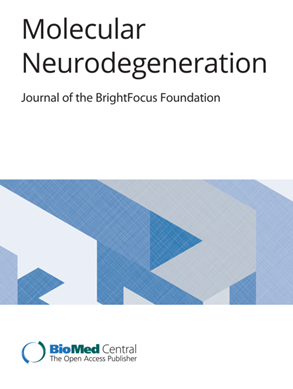TREM2 and sTREM2 in Alzheimer’s disease: from mechanisms to therapies
IF 17.5
1区 医学
Q1 NEUROSCIENCES
引用次数: 0
Abstract
Triggering receptor expressed on myeloid cells 2 (TREM2) is an innate immune receptor predominantly expressed by microglia in the brain. Recent studies have established TREM2 as a central immune signaling hub in neurodegeneration, where it triggers immune responses upon sensing pathological development and tissue damages. TREM2 binds diverse ligands and activates downstream pathways that regulate microglial phagocytosis, inflammatory responses, and metabolic reprogramming. Interestingly, TREM2 exists both in its membrane-bound form and as a soluble variant (sTREM2), that latter is generated through proteolytic shedding or alternative splicing and can be detected in cerebrospinal fluid and plasma. Emerging clinical and preclinical evidence underscores the potential of TREM2 and sTREM2 as diagnostic biomarkers and therapeutic targets in Alzheimer’s disease (AD). This review provides a comprehensive overview of the molecular functions, regulatory mechanisms, and pathological implications of TREM2 and sTREM2 in AD. Furthermore, we explore their potential roles in diagnostics and therapeutics while suggesting key research directions for advancing TREM2/sTREM2-based strategies in combating AD.TREM2和sTREM2在阿尔茨海默病中的作用:从机制到治疗
髓样细胞上表达的触发受体2 (TREM2)是一种主要由脑小胶质细胞表达的先天免疫受体。最近的研究表明,TREM2在神经退行性疾病中是一个中枢免疫信号中枢,它在感知病理发展和组织损伤时触发免疫反应。TREM2结合多种配体,激活调节小胶质细胞吞噬、炎症反应和代谢重编程的下游途径。有趣的是,TREM2既以膜结合形式存在,也以可溶性变体(sTREM2)存在,后者通过蛋白水解脱落或选择性剪接产生,可以在脑脊液和血浆中检测到。新出现的临床和临床前证据强调了TREM2和sTREM2作为阿尔茨海默病(AD)诊断生物标志物和治疗靶点的潜力。本文综述了TREM2和sTREM2在AD中的分子功能、调控机制和病理意义。此外,我们探讨了它们在诊断和治疗方面的潜在作用,并提出了基于TREM2/ strem2的抗AD策略的关键研究方向。
本文章由计算机程序翻译,如有差异,请以英文原文为准。
求助全文
约1分钟内获得全文
求助全文
来源期刊

Molecular Neurodegeneration
医学-神经科学
CiteScore
23.00
自引率
4.60%
发文量
78
审稿时长
6-12 weeks
期刊介绍:
Molecular Neurodegeneration, an open-access, peer-reviewed journal, comprehensively covers neurodegeneration research at the molecular and cellular levels.
Neurodegenerative diseases, such as Alzheimer's, Parkinson's, Huntington's, and prion diseases, fall under its purview. These disorders, often linked to advanced aging and characterized by varying degrees of dementia, pose a significant public health concern with the growing aging population. Recent strides in understanding the molecular and cellular mechanisms of these neurodegenerative disorders offer valuable insights into their pathogenesis.
 求助内容:
求助内容: 应助结果提醒方式:
应助结果提醒方式:


